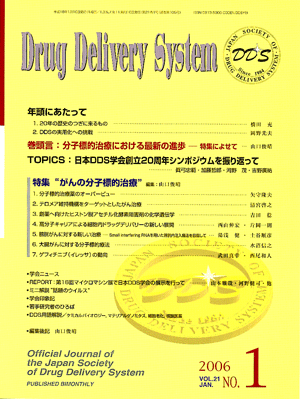All issues

Volume 21 (2006)
- Issue 6 Pages 592-
- Issue 5 Pages 492-
- Issue 4 Pages 388-
- Issue 2 Pages 102-
- Issue 1 Pages 18-
Volume 21, Issue 1
Displaying 1-7 of 7 articles from this issue
- |<
- <
- 1
- >
- >|
Feature articles “Molecular targeting therapy in cancer” Editor : Toshiharu Yamaguchi
-
Takao Yamori2006 Volume 21 Issue 1 Pages 18-23
Published: 2006
Released on J-STAGE: August 18, 2006
JOURNAL FREE ACCESSVarious gene products that play roles in oncogenesis and malignant progression of cancer have been identified following the recent development of cancer biology, which lead to the molecular target-based drug development. Molecular target-based drugs are targeted to such gene products that support the most critical functions of cancer. Therefore, they are expected to possess high efficacy against cancer and low toxicity to normal tissues of the host. The molecular target-based drug development started from the development of inhibitors of tyrosine kinases. The success of the development of Herceptin and Gleevec demonstrated the direction of such development is promising. The practical use of these molecular target-based drugs tells us the coming of new era of cancer chemotherapy.
Recently developed molecular target-based drugs are overviewed here.View full abstractDownload PDF (1552K) -
Hiroyuki Seimiya2006 Volume 21 Issue 1 Pages 24-31
Published: 2006
Released on J-STAGE: August 18, 2006
JOURNAL FREE ACCESSTelomere shortening at the ends of chromosomes is considered as one of the mechanisms for tumor prevention since critically shortened telomeres elicit a DNA damage response and induce cellular senescence. Immortality of cancer cells depends on telomere maintenance by telomerase. Thus, telomerase inhibitors have a potential to be new anticancer molecular targeting agents. Tankyrase 1, which enhances telomere access to telomerase, is another target for telomere-directed cancer therapeutics. It has been long postulated that anticancer effects of telomerase inhibitors depend on telomere shortening. Recently, however, new reports suggest another working mechanism for the agents, which is independent of telomere status of the target cancer cells.View full abstractDownload PDF (1453K) -
Minoru Yoshida2006 Volume 21 Issue 1 Pages 32-38
Published: 2006
Released on J-STAGE: August 18, 2006
JOURNAL FREE ACCESSHistone deacetylase (HDAC) is a family of enzymes that was discovered as a regulator of chromatin structure and function by means of chemical genetics. It is increasingly drawing attention as a molecular target for cancer therapy, since HDAC has been linked to tumorigenesis and tumor angiogenesis, and its inhibitors induce cell cycle arrest, differentiation and apoptosis in a variety of cancer cells.
This review focuses on the recent advance of chemistry and biology of HDAC inhibitors.View full abstractDownload PDF (1320K) -
Nobuhiro Nishiyama, Kazunori Kataoka2006 Volume 21 Issue 1 Pages 39-45
Published: 2006
Released on J-STAGE: August 18, 2006
JOURNAL FREE ACCESSDrug delivery system (DDS) is originally aimed to deliver drugs to the target tissue to improve the therapeutic effect as well as minimize the side effects. In addition to such control of biodistribution, another effects of drug carriers on the intracellular drug action have recently been attracting growing interests. It is assumed that drug carriers might control the cell entry as well as the intracellular localization and drug release, thereby affecting the pharmacological activity of the loaded drugs.
This paper reviews recent studies on such mechanisms of intracellular drug action of macromolecular drugs, and focuses were placed on their effects on the gene expressions related to the drug action.View full abstractDownload PDF (1748K) -
Takeshi Yuasa, Norihiko Tsuchiya2006 Volume 21 Issue 1 Pages 46-51
Published: 2006
Released on J-STAGE: August 18, 2006
JOURNAL FREE ACCESSBladder cancer arises from bladder urothelium and is localized in a closed cavity, which is readily reached transurethrally. Currently, the patients with superficial bladder cancer undergo transurethral resection followed by intravesical administration of immuno-reactive agents Bacillus Calmette-Guerin or anti-cancer drugs including mitomycin-C and adriamycin. These locally administrated agents can come into contact with cancer cells at high concentration for enough time in the closed cavity. It may be an ideal treatment model in which local drug delivery can maximize the anti-cancerous effect and minimize the side effect to vital organs outside the bladder.
In this review, we describe the current intravesical therapy as well as a pre-clinical and clinical trial of novel drugs and gene therapy. Moreover, we introduce our investigative therapy using small interfering RNA.View full abstractDownload PDF (1210K) -
Nobuyuki Mizunuma2006 Volume 21 Issue 1 Pages 52-57
Published: 2006
Released on J-STAGE: August 18, 2006
JOURNAL FREE ACCESSIn the past decade the median duration of survival with advanced colorectal cancer has increased from 12 months to nearly 24 months. Oxaliplatin and irinotecan are widely used in combination with 5-FU and leucovorin as FOLFOX (FU/LV+oxaliplatin) therapy or FOLFIRI (FU/LV+CPT-11) therapy. Recently two monoclonal antibodies showed significant activity for advanced colorectal cancer. Cetuximab is a chimeric Ig G1 monoclonal antibody that binds to EGFR. Cetuximab has significant activity when given in combination with CPT-11 or FOLFOX (FU/LV+oxaliplatin) chemotherapy.
Bevacizumab binds VEGF and prevents the interaction of VEGF to its receptors (Flt-1 and KDR) on the surface of endothelial cells. The interaction of VEGF with its receptors leads to endothelial cell proliferation and new blood vessel formation in in vitro models of angiogenesis. Administration of Bevacizumab to xenotransplant models of colon cancer in nude (athymic) mice caused reduction of microvascular growth and inhibition of metastatic disease progression. Bevacizumab also had significant activity Combined with FL (FU/LV), IFL (CPT/FU/LV) and FOLFOX (Oxal/FU/LV). These molecular target agents are going to the mainstay of the new era of cancer treatments.View full abstractDownload PDF (1606K) -
Masayuki Takeda, Kazuto Nishio2006 Volume 21 Issue 1 Pages 58-63
Published: 2006
Released on J-STAGE: August 18, 2006
JOURNAL FREE ACCESSGefitinib is an orally active, selective tyrosine kinase inhibitor that block EGFR transduction pathway. On the some phase III trails of gefitinib therapy, it failed to show survival benefit but EGFR mutations were correlated with gefitinib responses.View full abstractDownload PDF (1380K)
- |<
- <
- 1
- >
- >|